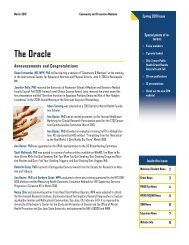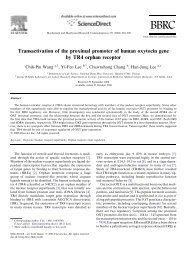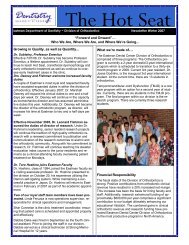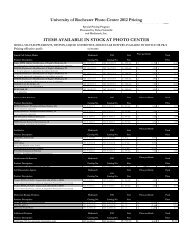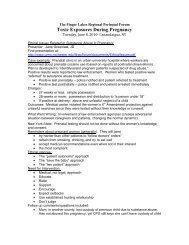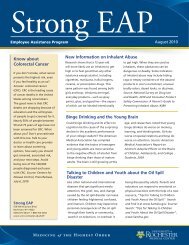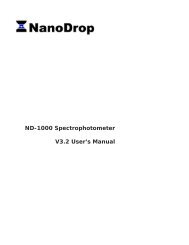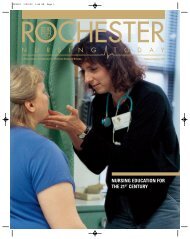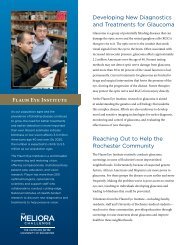Conservative Management of Pelvic Organ Prolapse
Conservative Management of Pelvic Organ Prolapse
Conservative Management of Pelvic Organ Prolapse
You also want an ePaper? Increase the reach of your titles
YUMPU automatically turns print PDFs into web optimized ePapers that Google loves.
680 Trowbridge and Fenner<br />
is very effective in alleviating symptoms and<br />
patient satisfaction is relatively high. Choosing<br />
a pessary type continues to be at the discretion<br />
<strong>of</strong> the physician. The evidence as to<br />
which pessaries are most effective in relieving<br />
symptoms associated with specific defects<br />
is a clinical question that remains to be<br />
answered.<br />
The role <strong>of</strong> physiotherapy in the management<br />
<strong>of</strong> pelvic organ prolapse still is in its<br />
infancy <strong>of</strong> development. Because the pelvic<br />
floor muscles contribute significantly to support,<br />
it would seem logical that improving<br />
muscle strength would improve support.<br />
Yet much work is needed to evaluate this<br />
theory. Specifically, the role <strong>of</strong> pelvic muscle<br />
rehabilitation in conjunction with reconstructive<br />
surgery is much needed information.<br />
References<br />
1. Samuelsson EC, Arne Victor FT, Tibblin G,<br />
et al. Signs <strong>of</strong> genital prolapse in a Swedish<br />
population <strong>of</strong> women 20 to 59 years <strong>of</strong> age<br />
and possible related factors. Am J Obstet<br />
Gynecol. 1999;180:299–305.<br />
2. Luber KM, Boero S, Choe JY. The demographics<br />
<strong>of</strong> pelvic floor disorders: current<br />
observations and future projections. Am J<br />
Obstet Gynecol. 2001;184:1496, 1501; discussion<br />
1501–1503.<br />
3. Cundiff GW, Weidner AC, Visco AG, et al. A<br />
survey <strong>of</strong> pessary use by members <strong>of</strong> the<br />
American Urogynecologic Society. Obstet<br />
Gynecol. 2000;95:931–935.<br />
4. Pott-Grinstein E, Newcomer JR. Gynecologists’<br />
patterns <strong>of</strong> prescribing pessaries. J<br />
Reprod Med. 2001;46:205–208.<br />
5. Clemons JL, Aguilar VC, Tillinghast TA,<br />
et al. Patient satisfaction and changes in prolapse<br />
and urinary symptoms in women who<br />
were fitted successfully with a pessary for<br />
pelvic organ prolapse. Am J Obstet Gynecol.<br />
2004;190:1025–1029.<br />
6. Clemons JL, Aguilar VC, Tillinghast TA,<br />
et al. Risk factors associated with an unsuccessful<br />
pessary fitting trial in women with<br />
pelvic organ prolapse. Am J Obstet Gynecol.<br />
2004;190:345–350.<br />
7. Clemons JL, Aguilar VC, Sokol ER, et al.<br />
Patient characteristics that are associated<br />
with continued pessary use versus surgery<br />
after 1 year. Am J Obstet Gynecol. 2004;<br />
191:159–164.<br />
8. Handa VL, Jones M. Do pessaries prevent<br />
the progression <strong>of</strong> pelvic organ prolapse?<br />
Int Urogynecol J <strong>Pelvic</strong> Floor Dysfunct.<br />
2002;13:349, 351; discussion 352.<br />
9. Heit M, Rosenquist C, Culligan P, et al. Predicting<br />
treatment choice for patients with<br />
pelvic organ prolapse. Obstet Gynecol.<br />
2003;101:1279–1284.<br />
10. Morgan-Jahanshir L, Shott S, Fenner DE.<br />
Factors affecting patients’ ability to retain<br />
a pessary. American Urogynecologic Society,<br />
19th Annual Scientific Meeting; Washington,<br />
DC; November 1998.<br />
11. Brincat C, Kenton K, Pat Fitzgerald M, et al.<br />
Sexual activity predicts continued pessary<br />
use. Am J Obstet Gynecol. 2004;191:198–200.<br />
12. Lazarou G, Scotti RJ, Mikhail MS, et al. Pessary<br />
reduction and postoperative cure <strong>of</strong> retention<br />
in women with anterior vaginal wall<br />
prolapse. Int Urogynecol J <strong>Pelvic</strong> Floor<br />
Dysfunct. 2004;15:175–178.<br />
13. Farrell SA, Singh B, Aldakhil L. Continence<br />
pessaries in the management <strong>of</strong> urinary incontinence<br />
in women. J Obstet Gynaecol<br />
Canada. 2004;26:113–117.<br />
14. Newcomer J. Pessaries for the treatment <strong>of</strong><br />
incompetent cervix and preterm delivery.<br />
Obstet Gynecol Surv. 2000;55:443–448.<br />
15. Wu V, Farrell SA, Baskett TF, et al. A simplified<br />
protocol for pessary management.<br />
Obstet Gynecol. 1997;90:990–994.<br />
16. Hendrix S, Cochrane BB, Nygaard IE, et al.<br />
Effects <strong>of</strong> estrogen with and without progestin<br />
on urinary incontinence. JAMA. 2005;<br />
293:935–948.<br />
17. Cundiff GW, Addison WA. <strong>Management</strong> <strong>of</strong><br />
pelvic organ prolapse. Obstet Gynecol Clin<br />
North Am. 1998;25:907, 921, viii.<br />
18. Alnaif B, Drutz HP. Bacterial vaginosis increases<br />
in pessary users. Int Urogynecol J<br />
<strong>Pelvic</strong> Floor Dysfunct. 2000;11:219, 222;<br />
discussion 222–223.<br />
19. Poma PA. <strong>Management</strong> <strong>of</strong> incarcerated vaginal<br />
pessaries. J Am Geriatr Soc. 1981;29:<br />
325–327.<br />
20. Frawley H. The effect <strong>of</strong> a physiotherapy<br />
treatment program for gynecologic surgery:<br />
a prospective, single blind randomized control<br />
trial (ongoing trial).<br />
21. Jarvis S, Hallam T, Dietz H, et al. Pre and<br />
Post-operative Physiotherapy Intervention



